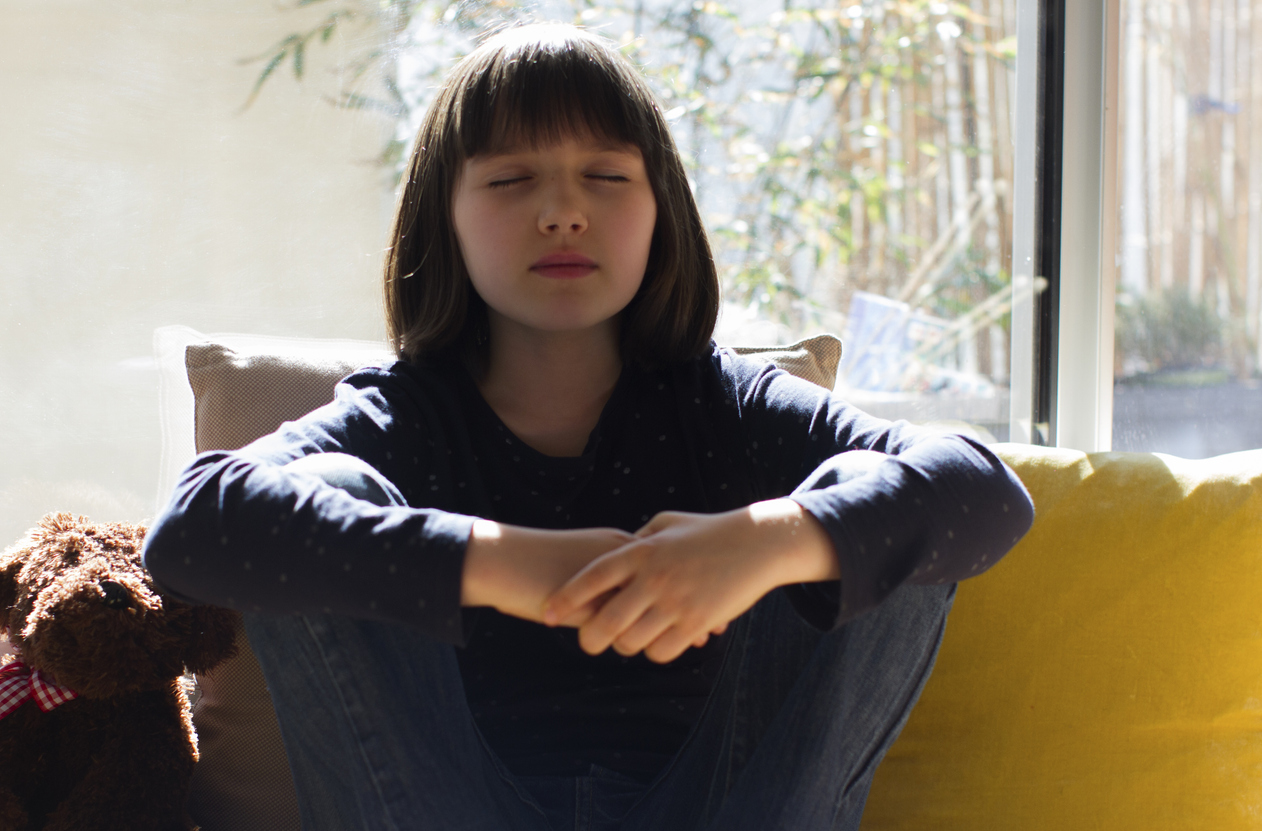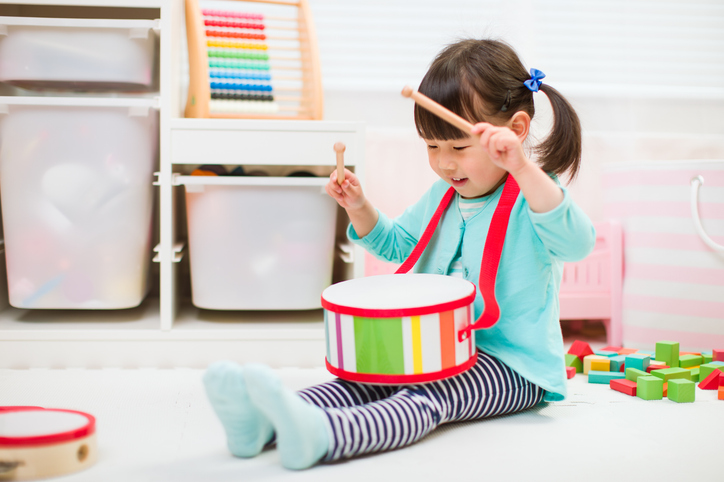More Digital, Less Dexterous?

The Kindergarten and Early Program teachers at Caedmon had begun to notice that a good number of their students were eating with their hands, no matter the kind or size of the food; more accurately, the children resisted using any cutlery. Many of their students also had no pencil grip or, at best, fisted their pencils and crayons. It was not laziness, the teachers surmised, but instead part of a larger and increasingly apparent problem. More and more of their students truly lacked fine motor skill development. How could this be?
As ours is a Montessori pre-K and elementary school, I found this particularly disconcerting and a genuine reason for worry. The children spend hours working on their fine motor skills, developing those many tiny muscles in their hands. They use tweezers to move small pieces of rice in beautiful bowls, transferring from left to right; similarly, beautiful glass marbles are spooned into corresponding small bone china trays. Clearly, however, the time spent in the classroom was not providing the training necessary for these children to achieve the level of dexterity that teachers expected of them developmentally. Something was not happening at home, or had replaced the activities at home that once supported and reinforced this very important and needed skill.
I listened to these teachers, and then pictured the many children I observe every day outside of school—on the bus, in a restaurant, even the very little ones in strollers waiting for their school-aged siblings. They are transfixed by the screen of a smart phone or an iPad, and their parents or caregivers are relieved to have them quiet and engaged. I asked myself if we aren’t creating a generation of children who will spend hours “watching” and maybe use an occasional swipe across a screen, with the result that they will lack the manual dexterity and the eye-to-hand coordination needed to perform even simple functions later on like tying their shoes and buttoning their coats.
What the Professionals Say
For the record, I am no Luddite, afraid of the demise of education as we know it due to technology and the eventual placement of our children and all of us in some version of the movie The Matrix. To the contrary, I have engaged in healthy and intense discussions, especially with Montessorians, arguing for the rich benefits with which technology can enhance curriculum. Montessori, with its focus on the tactile and with purposeful objects and movement, has declared a particular aversion to technology in general. I also always believed that a bit of healthy skepticism is appropriate with all conversations that toll the “end” of something, be it fine motor skills, the ability to spell, or the end of the world.
The briefest of internet searches elicits articles and research that address my original question. The American Academy of Pediatrics (AAP) published a set of guidelines for parents and educators following its May 2015 “Growing Up Digital, Media Research Symposium.” The introduction includes a somewhat disturbing statistic: “The 2013 Zero To Eight study commissioned by Common Sense Media showed that 38 percent of infants younger than age two use mobile devices like smartphones.”

In a subsequent New York Times blog, however, pediatrician Perri Klass points to the overall change in thought contained within the new AAP guidelines. Where earlier advice basically declared all screen time as bad for young children, these guidelines now recognize that interactions with some “educational” digital tools, as well as Skype and similar apps and sites that provide actual human-to-human interactions, can have a positive impact. The AAP recognized that, as an educational tool, “digital media can be used to facilitate executive function, build self-control and problem-solving skills, and improve children’s ability to follow directions.” The symposium also found that “developmentally optimized media . . . may play a key role in bridging the learning ‘achievement gap’ noted among low-income, disadvantaged, and underserved populations.”
Perhaps these conclusions reflect common sense but, while placing less emphasis on the media platform or time spent with media, the AAP continues to stress the need for quality content. It noted the caution of experts: “engagement with interactive media requires more than “pushing and swiping” to be educational.”
After reading the AAP report and Dr. Klass’s discussion of the impact of the new guidelines, three opinions struck me as extremely clear:
- “Media violence will never be good for kids; sexual content at a young age will never be good for kids; first-person shooter games will never be good for kids.” (This from Dr. Victor Strasburger, a co-author of the AAP’s original media guidelines.)
- “Unstructured, unplugged playtime is very important for all children and especially very young children. Whatever we may learn about what young children can or cannot learn from the screens in their lives, what we know is that they need human contact and interaction.” (The words of Dr. Bernard Dreyer, President of the AAP.)
- Ultimately, it is up to parents to model responsible media use. (This is a persistent theme throughout the AAP’s findings.)
More pertinent to my question is the aptly titled article, “Losing Our Grip: More Students Entering School Without Fine Motor Skills,” published in LancasterOnline, a digital news service for Lancaster County, Pennsylvania. The author explores the diminishment of fine motor skills seen by teachers in the Lancaster-Lebanon area and experienced throughout the country. What has caused this? Laura Cunningham, a local occupational therapist, says that many therapists believe the Back to Sleep campaign, which promotes putting babies on their backs to sleep to reduce the risk of SIDS, has contributed to delayed muscle development. If parents do not encourage wakeful tummy time, “toddlers might not be able to hold their bodies upright as well as their peers did years ago. They might not be as adept at spreading their hands and using their arms to push themselves up, a fundamental base for good seated posture and proper shoulder support when writing. Their eyes also may wander, making focusing on detailed tasks difficult.”
The author cites other contributing factors. “Today’s children also spend less time outside, where they might have more opportunities to explore how their bodies move through space, learn to balance and figure how to handle toys and tools in relation to one another.” There are also those children whose parents, out of safety fears, forbid certain physical play or handling scissors. Other parents “have traded in the messiness of hands-on play dough for a sterile ‘educational’ tablet.” The article concludes with Cunningham’s observation: “Rather than sit and color the way they used to do, our kids are part of the burst of technology. It’s amazing to see a kid who can swipe an iPad, but you put a pair of scissors in their hand and they don’t know what to do.”

Montessori and Fine Motor Skills
As mentioned above, our school is a Montessori school. Maria Montessori was adamant in her beliefs regarding the development of fine motor skills. The introduction to and ability to practice and master these skills are essential to the education and development of the youngest children. Beyond the mere physical task, there is a direct correlation to essential brain development, building one’s ability to sort, organize, categorize, etc. In the Montessori for Everyone blog, fine motor skills are broken down into four basic actions to be learned: “grasping, reaching, releasing an object, and turning the wrist.”
It makes sense that the “practical life” shelf in a Montessori classroom is where you find many of the activities, or works, that children engage in to develop the many small muscles in the hands. Tweezers, spoons, screw caps, buttons, latches and small pitchers of water, all made of beautiful, natural materials, are just a few of the items that are contained on these shelves. Perhaps even more telling in Montessori terminology is the accuracy of referring to the education in these early years as “normalization.”
A Call to Arms
So, should we sound the alarm? In all honesty, yes, I believe we have cause to raise serious concern. Schools and districts across the country are reporting 20 to 30 percent increases in their occupational therapy (OT) diagnoses. Is it an irreversible trend that spells doom? I do not believe that to be true. App designers and digital entrepreneurs are very sophisticated and more and more are creating intelligent and age-appropriate exercises. The STEAM and maker movements have also changed and enhanced technology, moving beyond mere screen time to intricate and exciting hands-on projects that involve coding and the actual building of materials.
All of that being said, however, doesn’t change the fact that this is something about which we must communicate loudly and engage in with our parents. Small blocks, Legos, putty, Play-Doh, sorting, tool manipulation, latches and buttons are all activities that need to be introduced or reintroduced to playtime at home. Parents can be referred to the AAP’s “10 Tips for Parents in the Digital Age.” I think what is most significant is that the tips are not earth-shattering surprises. In fact, most have less to do with actual technology than with age-old principles of child-rearing: “set limits and encourage playtime”; families who play together, learn together”; “create tech-free zones”; “don’t use technology as an emotional pacifier”; and “remember . . . kids will make mistakes using social media.”
Giving Our Children Everything They Need
Creativity is at the top of most 21st Century Learning lists. A direct product of a child’s imagination, it can take many forms and be displayed in many ways—with things that a child says, sings, draws and builds. In some ways, it is the very magic of learning, and children should not be denied the chance to have a full bag with which to make their magic.
References
American Academy of Pediatrics. “Kids & Tech: 10 Tips for Parents in the Digital Age.” HealthyChildren, 28 Sept. 2015. www.healthychildren.org.
Bourne, Lori. “Fine Motor Skills and Montessori Materials: A Perfect Combination,” Montessori for Everyone, 23 Jan. 2008. blog.montessoriforeveryone.com.
Brown, Ari et al. “Beyond ‘turn it off’: How to advise families on media use.” AAP News, 28 Sept. 2015. www.aappublications.org.
Klass, Perri. “A Reconsideration of Children and Screen Time.” The New York Times, The New York Times, 21 Mar. 2016. well.blogs.nytimes.com/2016/03/21.
Marselas, Kimberly. “Losing Our Grip: More students entering school without fine motor skills.” LancasterOnline, 26 Oct. 2015. www.lancasteronline.com.
Schifrin, Donald et al. (October 1, 2015.) Growing up Digital: Media Research Symposium. American Academy of Pediatrics. www.aap.org/en-us/Documents/digital_media_symposium_proceedings.pdf.
Matthew Stuart is Head of School at The Caedmon School, a school for children age 2.8 years through 5th grade, in Manhattan.
This article first appeared in the 2017 issue of the Parents League Review. Get the current issue of the Review free with a family membership. Or purchase it separately.












